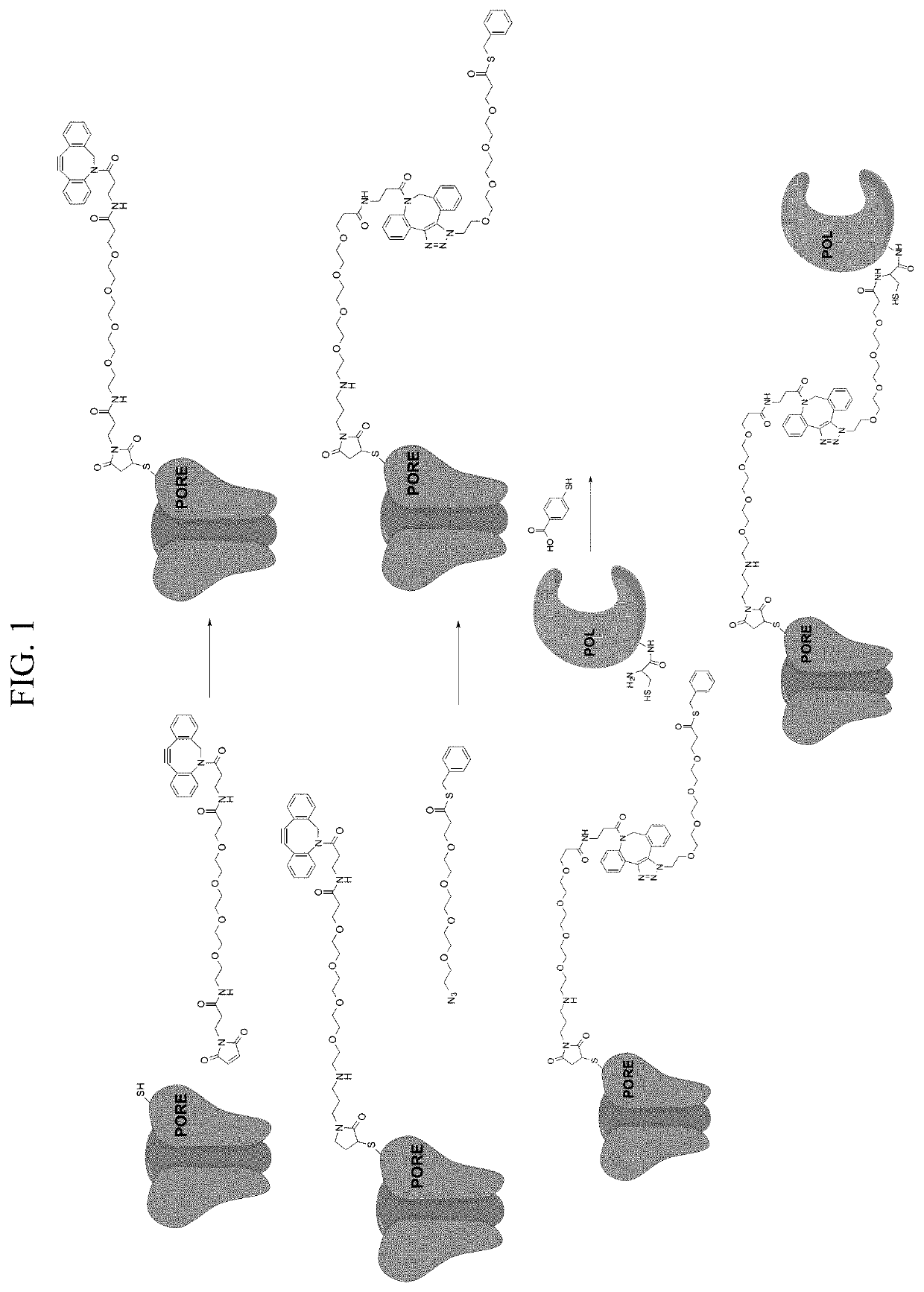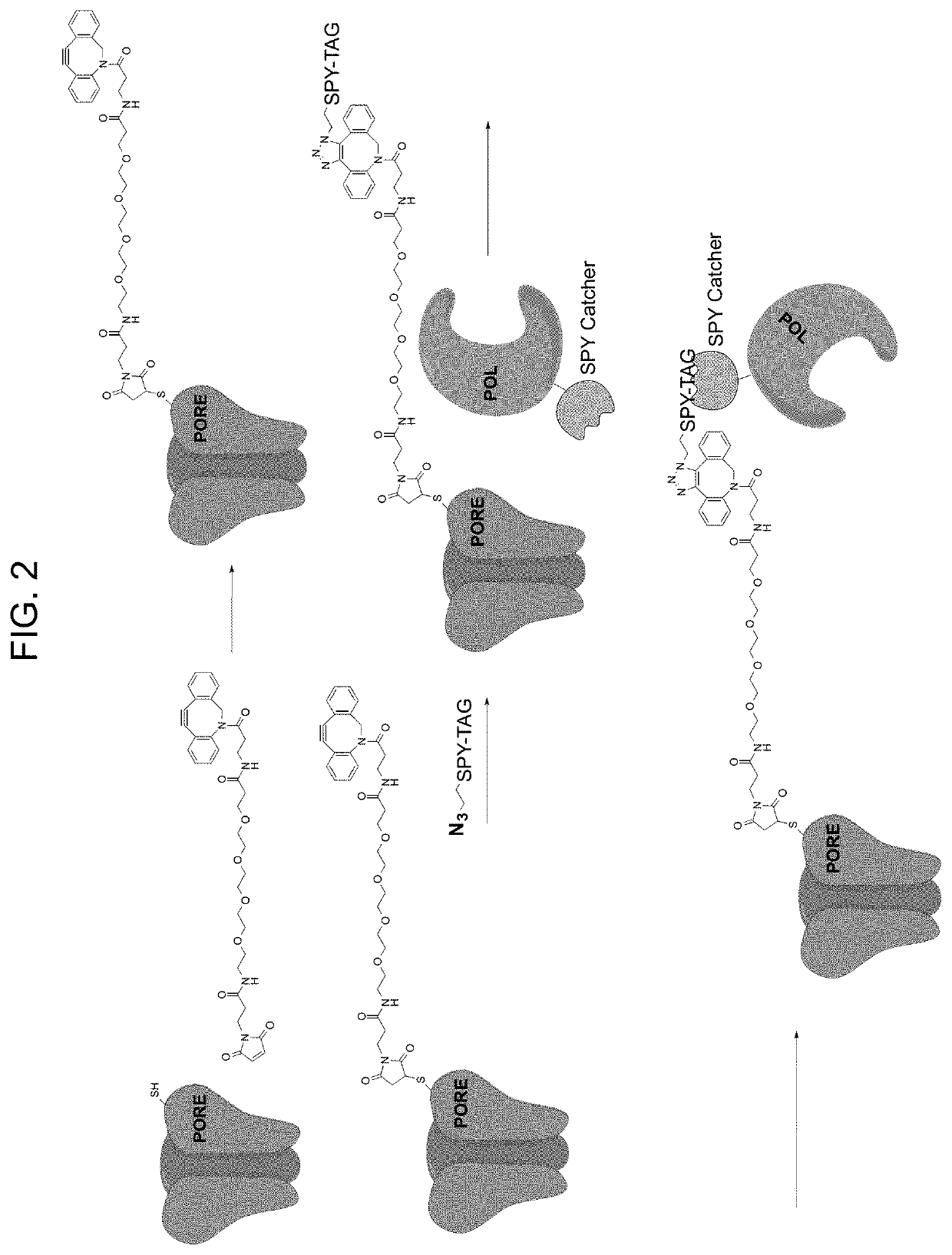Site-specific bio-conjugation methods and compositions useful for nanopore systems
a bioconjugation method and nanopore technology, applied in the direction of enzymology, peptides, transferases, etc., can solve the problems of limiting the kinetics of any reaction to conjugate these pore-forming proteins, in order to provide a nanopore sensor, and limiting the viable conjugation chemistries
- Summary
- Abstract
- Description
- Claims
- Application Information
AI Technical Summary
Problems solved by technology
Method used
Image
Examples
example 1
Site-Selective Conjugation of a Pore-Forming Protein to a Polymerase using Click-Chemistry and Native Chemical Ligation
[0163]This example illustrates the use of the site-selective conjugation method of steps (a)-(c) disclosed herein, wherein the B and Z reactive groups undergo a native chemical ligation (NCL) reaction in step (c). The example demonstrates preparation of a composition of formula (V), wherein the cysteine side-chain of an α-HL-C46 pore-forming protein that is part of a heptameric nanopore complex is conjugated to the N-terminus of a DNA polymerase (Pol), as depicted schematically in FIG. 1.
[0164]Materials and Methods
[0165]A. Pore-forming protein (e.g., α-HL) purification: The pore-forming protein monomers used are native α-HL and an engineered α-HL-C46, both encoded with 6-His tags for purification. The K46C (lysine at position 46 substituted with cysteine) mutant of a S. aureus α-HL monomer with a 6-His tag (“α-HL-C46”) is prepared using standard protein engineering ...
example 2
Site-Selective Conjugation of a Pore-Forming Protein to a Polymerase using Click-Chemistry and SpyCatcher-SpyTag Reaction
[0173]This example illustrates the use of the site-selective conjugation method of steps (a)-(c) disclosed herein with B and Z reactive groups providing a SpyTag peptide to SpyCatcher protein reaction in step (c). The example demonstrates preparation of a composition of formula (V), wherein the SpyTag-modified C46 residue of the α-HL-C46 pore-forming protein, that is part of a heptameric nanopore complex, is site-specifically conjugated to a SpyCatcher-Pol6 DNA polymerase fusion, as is shown schematically in FIG. 2.
[0174]Materials and Methods
[0175]A. Pore-forming protein (e.g., α-HL) purification: The pore-forming protein monomers used are native α-HL and an engineered α-HL-C46, both encoded with 6-His tags for purification. The K46C (lysine at position 46 substituted with cysteine) mutant of a S. aureus α-HL monomer with a 6-His tag (“α-HL-C46”) is prepared using...
example 3
Nanopore Sequencing using an α-HL-Pol6 SpyTag-SpyCatcher Conjugate as Prepared in Example 2 in a Nanopore Array
[0182]This example illustrates the use of the α-HL-Pol6 nanopore conjugates, prepared as in Example 2, in a nanopore array to sequence a nucleic acid. The α-HL-Pol6 nanopore conjugates are embedded in membranes formed over an array of individually addressable integrated circuit chips. This α-HL-Pol6 nanopore array is exposed to a JAM1A self-priming DNA template and a set of four differently 5′-tagged nucleotide substrates corresponding to the four nucleotides dA, dC, dG, and dT. As the specific 5′-tagged nucleotide that is complementary to the DNA template is captured and bound to the Pol6 polymerase active site, the “tail” of the tag moiety becomes positioned in the α-HL nanopore conjugated nearby. Under the applied AC potential, the presence of the tag in the pore causes a distinctive blocking current compared to the open pore current (i.e., current with no tag in the nan...
PUM
| Property | Measurement | Unit |
|---|---|---|
| molecular weight | aaaaa | aaaaa |
| molecular weight | aaaaa | aaaaa |
| molecular weight | aaaaa | aaaaa |
Abstract
Description
Claims
Application Information
 Login to View More
Login to View More - R&D
- Intellectual Property
- Life Sciences
- Materials
- Tech Scout
- Unparalleled Data Quality
- Higher Quality Content
- 60% Fewer Hallucinations
Browse by: Latest US Patents, China's latest patents, Technical Efficacy Thesaurus, Application Domain, Technology Topic, Popular Technical Reports.
© 2025 PatSnap. All rights reserved.Legal|Privacy policy|Modern Slavery Act Transparency Statement|Sitemap|About US| Contact US: help@patsnap.com



